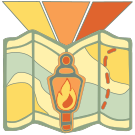Observe Parts of a Whole: Difference between revisions
No edit summary |
No edit summary |
||
| Line 10: | Line 10: | ||
|Topic3=Notice Other Wholes|Question3=Can you recognize that some "things" are part of more than one "whole", and some wholes share parts with other wholes? | |Topic3=Notice Other Wholes|Question3=Can you recognize that some "things" are part of more than one "whole", and some wholes share parts with other wholes? | ||
}} | }} | ||
There are | To get a glimpse into the flexible nature of our concept of "parts and whole," we can mindfully observe the things around us during any meal or snack. Try each of these at different times and see if you get that glimpse. Take your time to think about each of these ideas, and don't necessarily do all of these during one meal. | ||
* When you use a fork, do you consider that you have a handle, and the tines of the fork? There are really two halves to the fork in terms of utility, and some forks might even have a wooden handle and metal tines. Beyond that, you may think of the tines as one useful side of the fork, but try stabbing something small with just one of the tines. For that one moment, can you sense that each of the tines is its own thing? For a fork, it seems obvious it is "the whole" because it is forged from one piece of metal. However, each part can be considered alone as well. | |||
* | * What is your drink, or more specifically, what about the drink you see in front of you is necessary to maintain its identity? We know liquid is made of molecules, or even more simplistically "drops". But what happens if you take a sip of your drink? Is it now a new drink? Was that sip part of the drink? If so, it wasn't a mandatory part of it. | ||
* | * Other things around you such as chairs and tables are clearly made of parts, but we rarely need to think about that. But once you start listing the parts of a chair, it's very obvious that the parts (the legs, seat, back) are fairly uninteresting compared to the whole chair itself. | ||
* A sandwich is the perfect example of something that is both "the whole" and "the parts" at all times. A sandwich (or anything comparable) is so dependent on the parts being distinctive, but working in harmony. As you eat, think about what it would be like if one of the toppings wasn't there, or if it was all blended up first, or if you were to eat each part separately. The experience wouldn't be the same at all. | |||
* | |||
}} | }} | ||
<noinclude> | <noinclude> | ||
